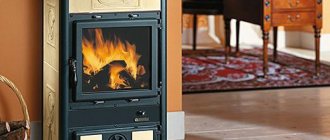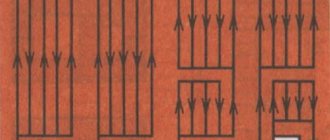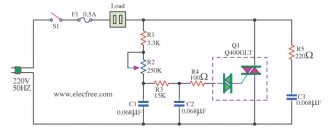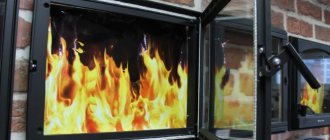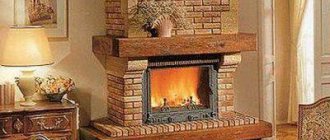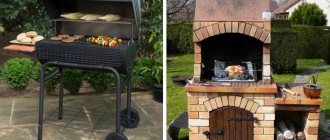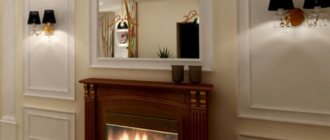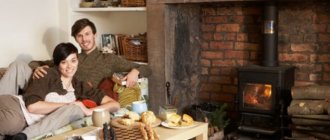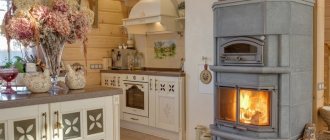What happens if you combine a fireplace and stove into one? What are the advantages of such a home heating system? Or maybe there are disadvantages? The answers are in this article.
How pleasant it is to spend an evening in your own home in front of the fireplace, enjoying the play of the flames and the relaxing warmth. Indeed, a fireplace can create a special atmosphere in the house. What if you add a stove to the fireplace, in which you can bake real bread or cook borscht, and in addition it will give warmth to the whole house. So such an opportunity exists in the form of a stove-fireplace design.
Description of the fireplace stove
A fireplace stove is a combined fireplace and stove that combines all the advantages and purpose. A fireplace can heat a room in a short time and create comfort due to the visible flame. The stove, although it takes longer to warm up than a fireplace, gives off heat for a long time, even after the fire has died out. In addition, the oven is used for cooking and heating food.
Main types
In words it is quite simple to explain the principle of unification according to which the fireplace stove is built. The real device is complicated by the fact that today it is customary to equip it with additional functions. Thus, there are models with ovens, hobs, niches for drying fruit, barbecues, barbecues, etc.
- Ancient traditions are embodied in modern stoves with benches. Of course, the stove has somewhat lost its purpose, and the stove bench serves, for the most part, to add some color, but it is functional. You can climb on it at any time and warm up. Such stove options require a dedicated area of the room. So think about where you can install it.
- Due to its shape, a wall-mounted wood-burning stove-fireplace does not take up very much space, but it allows you to heat two adjacent rooms at once. It is mounted so that its firebox opens into one room, and the back wall is part of the partition. In a small house, this design will provide warmth in any weather.
- A real center that can gather everyone around it is a stove with an oven and a hob. It can zone a room, allocating space for a full kitchen and a hallway. To welcome guests and prepare a festive dinner, it is enough to light only one firebox. As a result, you can get a warm room, a great view of the burning flame and a lot of cooking possibilities.
Home while working
Fireplace stove design
The fireplace stove system is quite complex; each element has its own characteristics that are clearly different from each other. The fireplace has a large open firebox, this allows you to create a large air draft, which means the fire will quickly flare up and warm the room. And in order to remove combustion products without delay, the fireplace has a straight exhaust pipe. But as soon as the flame goes out, the heat stops flowing into the house. The oven has a completely different principle of operation. It does not require a large firebox and strong draft, so the fuel does not burn, but rather smolders, gradually heating the stove. The heat accumulates and warms the house for a very long time, even without fire in the firebox. And the winding exhaust pipe only contributes to this, trapping hot gases.
The stove makers managed to combine the stove and fireplace together. You can’t heat all the fireboxes at once, but if there is a need for this, you should light the fireplace and then the stove. Since the fireplace has a more powerful air draft.
Required tools and materials
To make a brick fireplace stove yourself, you need to prepare the following materials:
- Heat-resistant brick - its quantity is determined by the size of the object. An average design will require approximately 800 pieces.
- Heat-resistant mixture - it is made on the basis of clay or oven glue.
- Doors with fireproof glass.
- Doors for the firebox and vent holes.
- Cooking plates.
- Materials for thermal insulation.
- Steel angles, plates, sheets.
- Wire.
- Double pipes and chimney openings.
- Cement, sand, crushed stone.
- Heat-resistant floor covering.
The list of necessary equipment and materials may vary depending on the drawing and final appearance of the entire heating facility.
Models of fireplace stoves
They build different models of the stove-fireplace system. The differences are in the material, which affects the performance of the equipment. There are also fireplace stoves of different shapes, which allows you to install them in the house based on the internal layout. There are corner, island and wall-mounted ones. Their shape affects the external design, for example, a corner one does not need decorative cladding on the sides of the walls. The main materials for the production of fireplace stoves are cast iron or steel and brick. Brick ones have a lot of weight and size, so they need to strengthen the foundation. They accumulate heat well and share it for a long time. A brick fireplace stove can be installed so that the fireboxes open into different rooms. This will not spoil the interior and will have a positive effect on heating the house.
Cast iron or steel are produced as a monoblock, which is convenient for installation. The properties of cast iron are that it has a lower heat capacity than brick. When heated, cast iron emits infrared heat, warming people and objects, rather than airspace, and does not create air currents that raise dust particles.
Operating rules
When lighting a wood-burning tunnel fireplace, you must strictly adhere to basic safety rules.
- Never leave a burning fireplace unattended. Also, do not leave children near the fireplace without adult supervision.
- The area around the fireplace should be made of non-flammable materials to prevent a fire if coals fall out.
- It is best to install a protective screen next to the fireplace insert to prevent coals from falling out.
- It is necessary to use well-dried firewood.
Advantages and disadvantages
The advantages of a double-sided fireplace include the following points.
- Stylish and unusual design. Such a fireplace will undoubtedly become the main accent in any interior.
- Possibility of zoning space.
- Wide range of models.
- You can easily choose the right firebox for any budget.
Minuses
- Complex installation process, like any other wood burning fireplace.
- The cost of laying out the frame for a wood-burning fireplace will be quite high.
- Fire hazard when operating a wood-burning fireplace.
PC orders
Stoves and fireplaces designed and built by Georgy Reznik are distinguished by high thermal qualities and a precise design, which is based on the image of a traditional Russian stove. You can once again be convinced of this by familiarizing yourself with the new order of the heating stove-fireplace.
The design of the proposed fireplace stove is intended for heating a room with an area of up to 30 m2 and a ceiling height of about 250 cm. If the fireplace stove is installed in a hall (large room), it should be turned with the stove part towards the wall or partition with a distance of at least 125 cm. This distance is sufficient for working near the stove. The fireplace stove can also be installed in the opening of a wall or partition between the living room and the kitchen. In the heating and cooking furnace, the convective system is a bell-pack system, which allows you to install a low mounted pipe. For a one-story building, this is important, since there is no need to raise the pipe high above the roof. The oven has two modes - summer and winter. When the summer valve is open, flue gases enter the chimney, bypassing the hoods and without heating the furnace mass. A ventilation valve is installed in the upper part of the cooking chamber. The stove is equipped with an oven.
The main mass of the fireplace stove is made of stove (Vitebsk) brick. Both fireboxes (stove and fireplace) and parts of the adjacent chimneys are made of fireclay. For a more expressive design, decorative elements (shelves, arches, skirt, bottom sill) can be made from solid brick, the color of which differs from the main color of the stove (for example, from Pobeda Knauf brick). You can further decorate the stove by covering the shelves with ceramic tiles or natural stone.
MATERIALS AND DEVICES REQUIRED FOR CONSTRUCTION OF STOVE-FIREPLACE Red brick M-200 - 1200 pcs. - "- fireclay Sh-8 - 170 pcs.; Fireclay clay - 50 kg. Crushed fireclay - 50 kg. Smoke valve 26×13 cm - 3 pcs.; —“— 13×13 cm — 1 pc. Cast iron two-burner stove 58.5×34 cm - 1 pc.; Fire door 21×25 cm -1 piece; -“- blower 13×25 cm -1 piece; -“- for cleaning 7×13 cm -3 pcs. Grate 25×30 cm - 2 pcs. Oven 35x28x25 cm - 1 pc. Steel strip 50x5 mm -8 m. Steel angle 60x60x6 mm -2.5 m. Clay, mountain sand - as needed.
Tips to help you at work
If you decide to do the assembly yourself, we recommend taking the following useful tips as a basis to help you organize and carry out the work:
- Brick fireplace stoves for summer cottages must have the same thickness of seams in all areas (4-6 millimeters);
- The evenness of the first row is checked both using a standard level and in a diagonal direction;
- Before you start laying the next row, additionally check the evenness of the previous one. To do this, use a protractor. The horizontal is checked using a building level, and the vertical is checked using a plumb line;
- If you plan to install a hob, to better fix it and protect the brick from constant overheating, apply a large layer of fresh clay mixture (about 5-7 millimeters) to it;
- In order for the heating unit to have good draft, the device is equipped with a summer operation. Thus, the removal of gases and all decomposition products will be carried out in a short way;
- A stove with a fireplace for a brick cottage should be laid out starting from the corner in each row;
- The joints of the previous row must be covered with bricks of the next one;
- The cross-section of the chimney and smoke collector always have the same diameter and shape.
Small shelves are suitable for drying berries, fruits, plants, and also have a decorative function
Brick stoves can be equipped with a purchased metal or cast iron hearth
In order to increase efficiency and heating speed, the design can be equipped with several hearths
For a detailed visual acquaintance with the preparatory stage of work and useful recommendations for the construction and selection of a brick fireplace for your summer cottage, you can also watch the video in this article.
Brick stove-fireplace. Phased construction
Analyzing the thermal performance of heating centers, both newly built and in operation for many years, I came to certain conclusions. To some, my comments will not seem new, but they will be useful for owners of country houses with stove heating, as well as for workers who have some experience in constructing brick fireplace stoves.
Brick stove-fireplace construction
Let's start with the foundation. Its depth should be below the calculated freezing depth. It is strictly forbidden to connect the foundations of the stove and the house. It is necessary to perform double waterproofing: the first - at the soil-air boundary, the second - 10 cm before the level of the subfloor.
What materials should I use? Red clay brick. Before laying, it should be soaked in water for better adhesion to the clay-sand mortar.
The strength of the masonry depends on the fat content of the clay. To eliminate shrinkage, sand is added to the clay. The best clay is the one that has been left in the cold. The sand grain size should be 1…1.5 mm. This will make it possible to make the masonry stronger due to thin seams.
The old masters said about sand: “Which sand crunches in your hands and does not make stains when poured onto a white scarf, is suitable for the structure of a furnace.”
The firebox of a brick fireplace stove must match the fuel being burned. But in all cases, slopes are laid from the grate to the walls of the firebox, which helps coals or unburned firewood to roll onto the grate and “finish burning.”
Soot and condensation. To combat the loss of condensate and soot on the walls of chimneys and pipes, a suction channel (“ram”) is installed, which is a small window 70x70 mm made from the firebox into the last channel.
The stove must have good constant draft. This is achieved by smooth outlines of turns, narrowings and expansions of chimneys. The height of the pipe from the level of the grate to the head must be at least 5 m. Weak draft leads to soot deposition.
It must be remembered that burning a stove with chimneys on which soot particles have settled requires much more fuel and time.
A layer of soot 3 mm thick reduces the heat transfer of the masonry by 2 times. Birch firewood produces the most soot, while aspen firewood produces the least amount of soot.
Some innovators in the furnace industry insert 070 mm metal pipes into vertical smoke ducts to accelerate heat transfer from the furnace. The ends of the pipes, bent at the top and bottom, go out. Due to air convection, the room warms up faster.
How often and for how long to light a brick fireplace? - many developers ask. The heating and cooking stove is heated for 1.5 hours, the heating stove - up to 2 hours, the sauna stove - up to 4 hours. But if you need to get more heat, then it is more profitable to heat the stove twice with a break of 5-6 hours than continuously and for a long time. Fuel savings are also achieved through proper operation.
Stoves combined with fireplaces do not always have uniform heating of all masonry walls, but if such a fireplace is installed in one large room or the partitions adjacent to the heating structure are correctly constructed, then maximum comfort can be obtained.
When developing any design, you have to take into account many factors: the size and location of the rooms, the presence of a foundation, and if there is one, then its
dimensions
I had to develop an oven with a single burner stove and an oven for drying vegetables and berries. The stove had to be installed in a room with an area of 30 m2 and be used at any time of the year, so it was necessary to provide two fire modes: summer and winter. In addition, the customer wanted to have a built-in fireplace. The matter was complicated by the fact that the area of the existing foundation was only 1x1 m.
To develop the design and calculate materials, a kit for prototyping stoves and fireplaces was used. In this case, a completely new design of a compact heating and cooking stove combined with a fireplace was obtained.
The pictures show sections and arrangements of a brick fireplace stove.
How to build a foundation
The weight of an average static fireplace stove (with a chimney) reaches four tons. Therefore, it is imperative to build a solid foundation for it. One part cement goes to three parts sand. A fifth of the solution is crushed stone. Sometimes good quality natural stone is used to make the foundation. You cannot replace it with construction waste or broken bricks, as this will significantly weaken the concrete.
Important! A frame made of reinforcement must be laid inside a solid concrete foundation.
The structure of the frame, methods of tying reinforcement and thickness depend on the design and size of the furnace. The building and the fireplace have different shrinkage parameters, so their foundations cannot be connected together to avoid structural failure.
When building a fireplace stove with your own hands, you must comply with all building regulations. When performing foundation work, you need to correctly calculate the depth. It is important to know how to properly reinforce a structure and assemble formwork. After the foundation is poured, the required period of concrete maturation is maintained, and only then the laying begins.
It’s not enough to understand theoretically how to build a fireplace stove with your own hands. You need to listen to the advice of experienced craftsmen. After all, seemingly small defects and omissions can become critical during the operation of a heating structure. When it comes to a combined model, it is necessary to comply with building regulations at all stages of construction.
Using a ready-made project
In order to build your own Russian stove with a sun lounger and a fireplace opening into the room, you can use a ready-made project adapted to modern requirements. The website provides a photo with ready-made designs of this design No. 132(A) RP - 4800. The heater can heat up to 45 m* of space, has two heating units and an overall size of 1410*2040 mm. The project consists of a set of developed drawings, specifications and step-by-step instructions. On the same resource you can find other designs of stoves with a different arrangement of the stove bench and fireplace.
The stove will acquire its individuality only after it is lined. It must have clean, even masonry seams, and the entire front surface must be cleaned using abrasive materials. After this, the surface is decorated by any available means, and becomes a source of pride for the master.
However, not everyone can create a Russian stove with a stove bench with their own hands, especially if you need a fireplace. This work requires skills, dexterity and a lot of time. It will become more expensive to remodel a poorly constructed, bulky structure. The work of a master is highly valued, but the design will work for many years.
Russian stove with fireplace and stove bench
Can a fireplace be installed in any room of the house or are there restrictions?
There are a lot of restrictions. It is not allowed on the second floor (usually the ceilings are not designed to support the weight of even a small fireplace), in a regularly shaped room with an area of at least 20 square meters with three-meter ceilings, so that the volume of air is sufficient for normal combustion. But a fireplace that is too small will not be able to heat a large room. For masonry fireplaces there is a rule:
area of the combustion window = 1/50 of the area of the room.
The firebox window should “look” into the middle of the room.
Trial fire
It is normal to light the stove for the first time, it is possible when the masonry is dry. It is necessary to perform the following sequence of actions:
- For 2 weeks, the stove is heated with small amounts of fuel, made from thin logs and wood chips. It is not advisable to completely cool the oven. The quality of heating is checked by placing crumpled newspapers in the cleaning channels. A small fire will not set the paper on fire, but how damp it becomes will indicate the quality of drying;
- The final one is also done gradually, you need to heat it several times a day, gradually increase the power of the flame, increasing the amount of firewood.
The frequency of cleaning the channels depends on the fuel used, generally this should be done 1-2 times a year. To clean smoke ducts, experienced stove makers recommend heating a Swedish stove with a fireplace with dry aspen wood once every 2 weeks. It is best to clean the pipe from soot manually, or using a homemade electric soot brush.
Step-by-step manufacturing instructions
A stove with a fireplace should be placed in the house so that its hob and firebox are directed towards the kitchen, and the fireplace faces the living space. It fits well between separate rooms.
In principle, it can be installed anywhere; if you do not plan to cook on the stove, then you can use it as a design element and decorate it with decorative material. It is better if the stove is planned during the construction of the house, it is easier to create a reliable foundation, because the mass of the entire structure is approximately 3 tons.
The Swedish stove with fireplace is shown in the diagrams:
Front view
Back view
Section #1
Section #2
Materials and tools
The required materials are presented below:
The materials used to prepare the masonry mortar are of great importance. Simple clay is not able to withstand high temperatures, you need to find fireclay clay. Anyone who wants to prepare it themselves needs to look for it in hollows near rivers or on their steep banks.
You need to prepare the tools in advance, of which you will need:
- Master OK;
- Rubber mallet and hammer-pick;
- Twine and plumb line;
- Rule;
- Tape measure, pencil.
Lay out the oven
If you wish, you can download the project of a Swede with a fireplace by A.I. Ryazankina.
The order of the Swedish stove with a fireplace is presented below:
1-6 row
7-12 row
13-24 row
25-33 row
First of all, it is necessary to make a foundation for the stove. After this, the laying begins in order (images above).
The first row of masonry must be placed on a waterproofing layer. In order for the masonry to be level, this affects the placement of the entire structure; markings must be made on a sheet of material for waterproofing - for this purpose, you will need a long ruler, a corner and white chalk. With the exact outlines of the future oven, it will be much easier to complete the work; according to the resulting markings, they begin to lay out the first row.
It is necessary to bandage the bricks. Check that the corners are laid out correctly and the structure is horizontal. These rows are necessary as the basis for the entire structure; you cannot make mistakes when laying them out. The rods on which the fireplace grate will rest must be walled into the masonry in the 2nd row.
Finishing
In absolutely all cases, the resulting fireplace will have to be decorated from the outside. It can simply be coated with a layer of glossy or matte paint. Here you need to remember the elementary laws from the physics course. Dark bodies emit more energy, and since our task is to remove energy, black colors will be a priority.
Good to know: How fireplaces are placed in interiors with different themes and styles
The fireplace can be finished with special fireproof materials. These include tiles made of ceramics, artificial and natural stone. When gluing tiles, you should remember the thermal expansion of the metal, so the seam gap should be slightly increased.
With the possibility of making your own fireplace, a lot of opportunities open up for you to realize your old dream exactly in the form in which it interprets itself. Desire and work in a certain sequence will ensure an excellent result.
Security measures
Do not forget that a fireplace is, first of all, a source of increased danger if you do not look after it. Any spark that accidentally jumps out of it can cause a fire.
Therefore, there are certain safety precautions that must be observed:
- The walls of the fireplace get very hot, so it is contraindicated to place it in children's rooms. That is why there are requirements for insulating walls and floors;
- The chimney, through which combustion products must escape, is made with an outlet through the roof to the street. That is why it is important to choose the right place so that there are no problems with the removal of parts.
